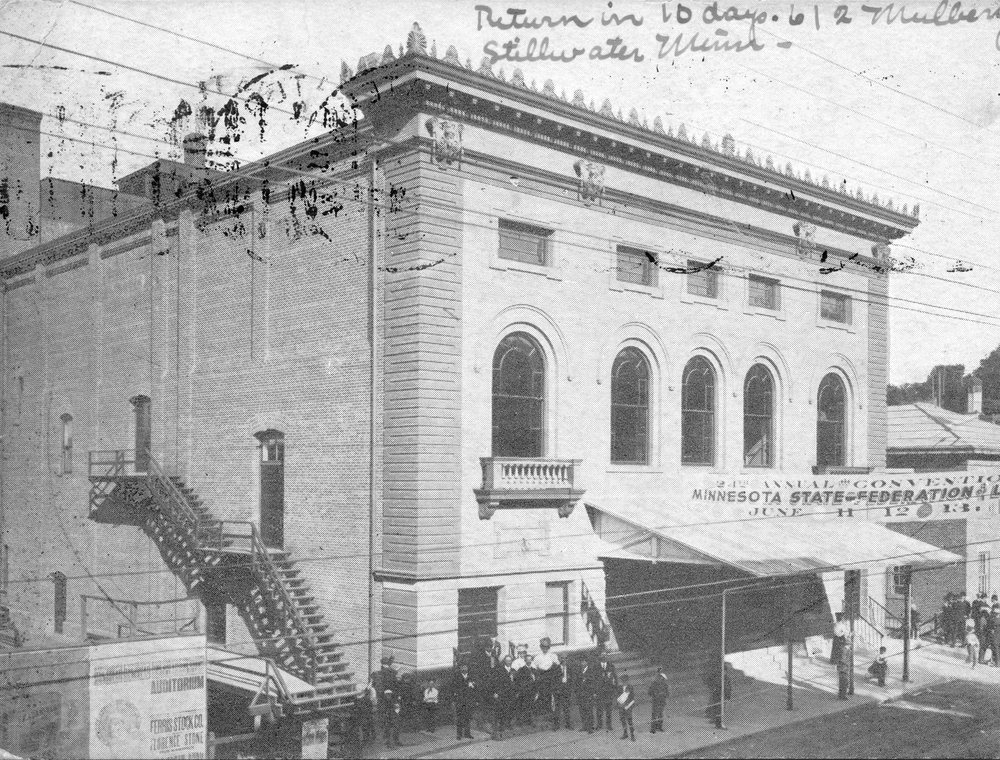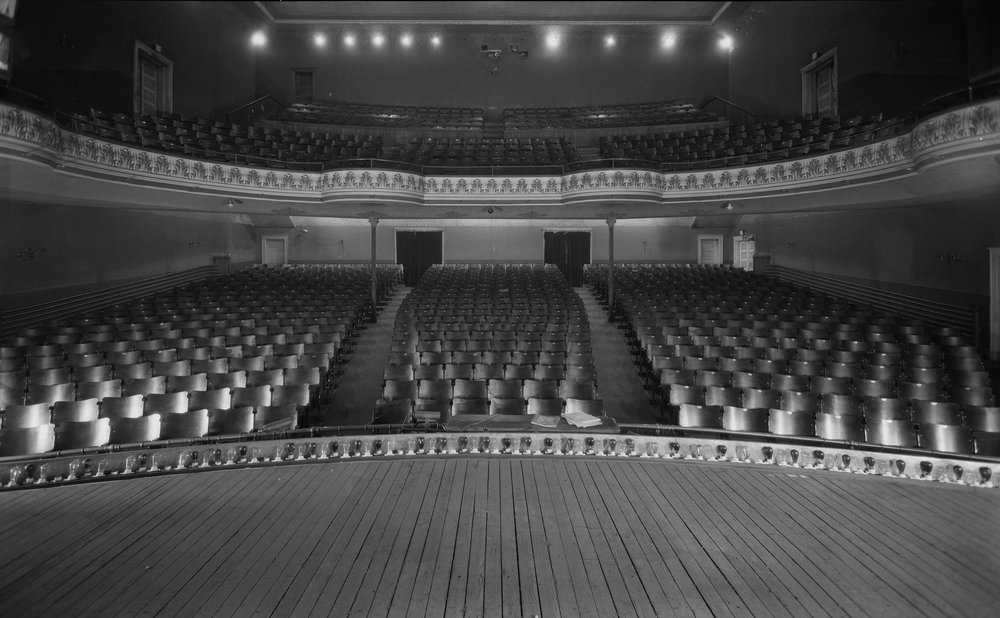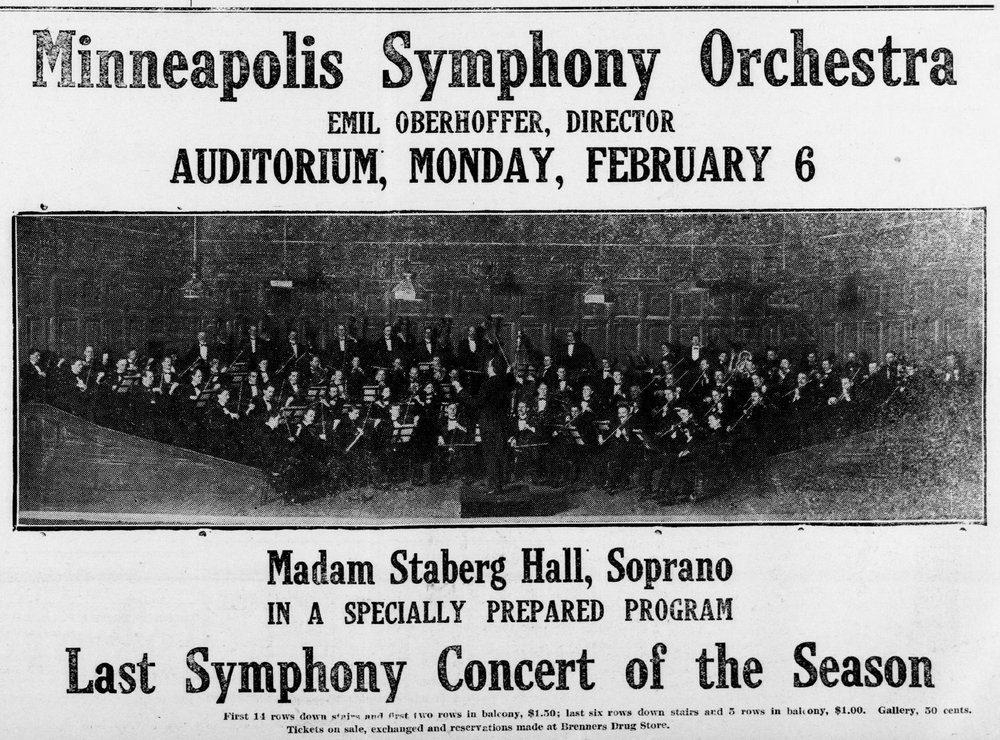Auditorium Theater
After the fire destroyed the Grand Opera House on Main Street, Stillwater in 1902, there was a call for rebuilding the building. After a couple years of back and forth, it was decided to build another building in another location. That location was described as being on the “east side of Second Street between Olive and Chestnut.” The new “Auditorium” was to be 105 feet of street frontage and extended back 140 feet to Union Alley.
The Auditorium Committee consisted of A. G. Triebel, Chairman, Robert G. Slaughter, Judge Frank T. Wilson, M. Lee Murphy, Eugene O’Neal, Hugh D. Campbell and Londrus Sargeant.
The committee contracted with architect F. W. Kinney to draw the plans. The concept had 1,000 seats, with four boxes on each side of the stage. O. H. Olsen of Stillwater won the bid to construct the building for $30,975. The plans were later modified to reduce construction costs to just under $30,000, allowing the building to open free of debt.
The opening of the new Auditorium took place on January 27, 1906 with a two act musical comedy called, “Piff, Paff, Pouf.” At 8:30 p.m. the lights dimmed and Stillwater Mayor James Armson welcomed the crowd. Between the acts, Minnesota Governor John A. Johnson addressed the spectators. At the end of the performance, the entire crowd and actors sang “Auld Lang Syne” before the curtain dropped for the first time.
Regional and national performance groups stopped at the Auditorium Theater on their tours. Locals also performed there; many residents later remembered the Stillwater Elks Club and its “fast moving minstrel shows.”
As the 1920s were approaching, the Auditorium gave way to the onset of motion pictures. In 1919 the first movie shown was a ten-reel version of the Shepard of the Hills, with “augmented orchestra” providing the sound. Many of the early movies shown were silent films that an orchestra or just a piano player would highlight the movie with their music.
Sound came as soon as it could to the Auditorium Theater. In July 1939 the sound system was updated with the new Philharmonic Multi-Beam Sound-on-Film equipment. The first film to be shown with this new system was “Invitation to Happiness,” starring Irene Dunne and Fred MacMurray. According to the Stillwater Gazette, “This equipment places Stillwater in the class of the larger towns of the Northwest in that it will enable patrons of this theater to enjoy the latest and most improved type of talkies.”
The Auditorium Theater continued to show the finest movies from around the country. By the 1960s it was in decline, but hopefully a new endeavor would bring back the crowds as the owners of the Auditorium allowed the old stage area to be used as a youth center. It was aptly named “The Stage Door.”
The Stage Door included a kitchen that served nearly everything the young people would want, from hamburgers, cheeseburgers, malts, coffee, pop, and ice cream. There were two “good sized” lounges off the entrance lobby and a sound proof office where the business for the club would be conducted.
The main attraction for the club was the 3,200 square foot dancing area. Here is where the teenagers would gather for dances with music played by local bands.
The club opened on June 21, 1967. Membership was needed to enter the club, at a cost of $5 per year. Members had to be enrolled in the Stillwater junior or senior high school. However, membership could be retained until the age of 21. Some of the local bands that played at the Stage Door included The Doctor Nothings, The Fifth, the Changing Times, and The "In-Sane.”
By the early 1970s the Stage Door was gone and the Auditorium had closed. In 1972 the Theater opened again, and seemed to be able to take a foothold. Unfortunately the building was is poor condition and even though the owners tried to maintain the facility, it was deemed too deteriorated to repair. In November, 1976, 70 years after it opened, the Stillwater was razed to make way for a parking lot and bank drive-through.
The memories of going to the movies in the theater are still fresh today, the large stairway going to the balcony, the mauve colored curtains and the large stage and screen which many saw their first movies on.
—Brent Peterson
Brent Peterson is Executive Director of the Washington County Historical Society



